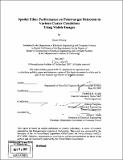Spatial filter performance on point-target detection in various clutter conditions using visible images
Author(s)
Hwang, Susan, M. Eng. Massachusetts Institute of Technology
DownloadFull printable version (13.02Mb)
Alternative title
Spatial filter performance on various clutter conditions
Other Contributors
Massachusetts Institute of Technology. Dept. of Electrical Engineering and Computer Science.
Advisor
Frederick K. Knight and George Verghese.
Terms of use
Metadata
Show full item recordAbstract
For a search-and-track system, detection of point targets in clutter is a challenge because spatial noise in an image can be much greater than temporal noise. Suppression of clutter uses a spatial filter matched to the target size. The goal of filtering is to reduce the spatial noise to the temporal noise limit. In this thesis, the detection performances of the Laplacian, Median, Robinson and Mexican Hat spatial filters were compared to determine the best filter and unveil trends in the dataset. The sky images were collected on top of the Lincoln Laboratory roof in Lexington, Massachusetts with a visible imager (1024x1024 pixels, 170 and 15prad resolution) over three months, seven times a day, fifty frames each time. Artificial targets of a range of intensities near the temporal noise limit were embedded throughout the entirety of the images to be filtered. After filtering, the performance of the filters was calculated using the Neyman-Pearson Detection method that was implemented with MATLAB. The Laplacian filter was found to be the best performing filter over the entire dataset with the other three filters performing almost as well, only averaging 5 percent to 9 percent worse than the leading filter. Trends in the dataset show that performance is also dependent on time of the day (e.g. morning, midday, after sunset), spatial standard deviation, temporal standard deviation and on resolution of the images (1024x1024, 512x512, 256x256). The conclusions of this thesis give a comparison of spatial filters and a deeper understanding of the dependence of the filter performance over a range of variables which can be later used to improve a detection scheme for point detection in search-and-track systems.
Description
Thesis (M. Eng.)--Massachusetts Institute of Technology, Dept. of Electrical Engineering and Computer Science, 2007. Includes bibliographical references (p. 87-88).
Date issued
2007Department
Massachusetts Institute of Technology. Department of Electrical Engineering and Computer SciencePublisher
Massachusetts Institute of Technology
Keywords
Electrical Engineering and Computer Science.